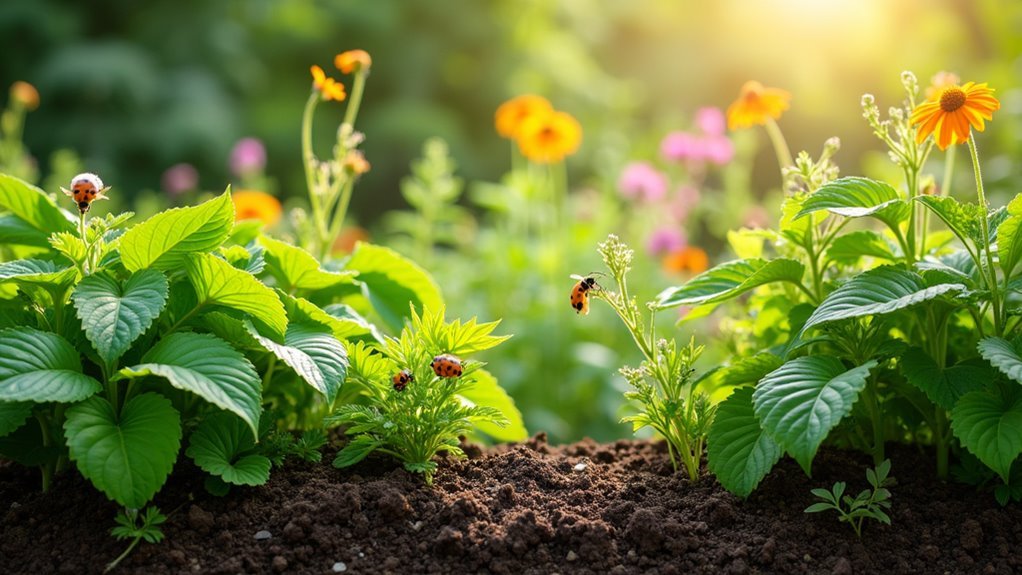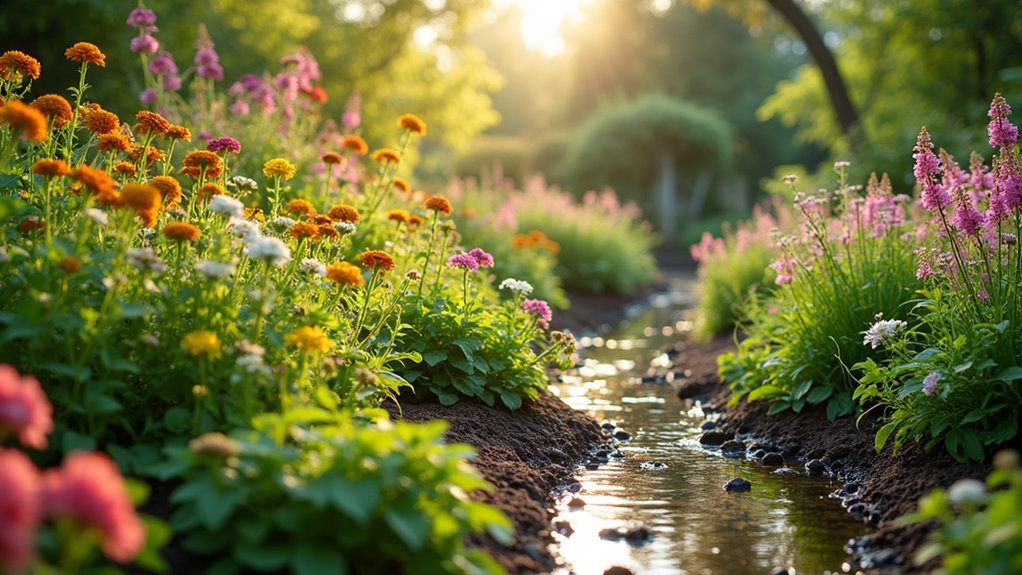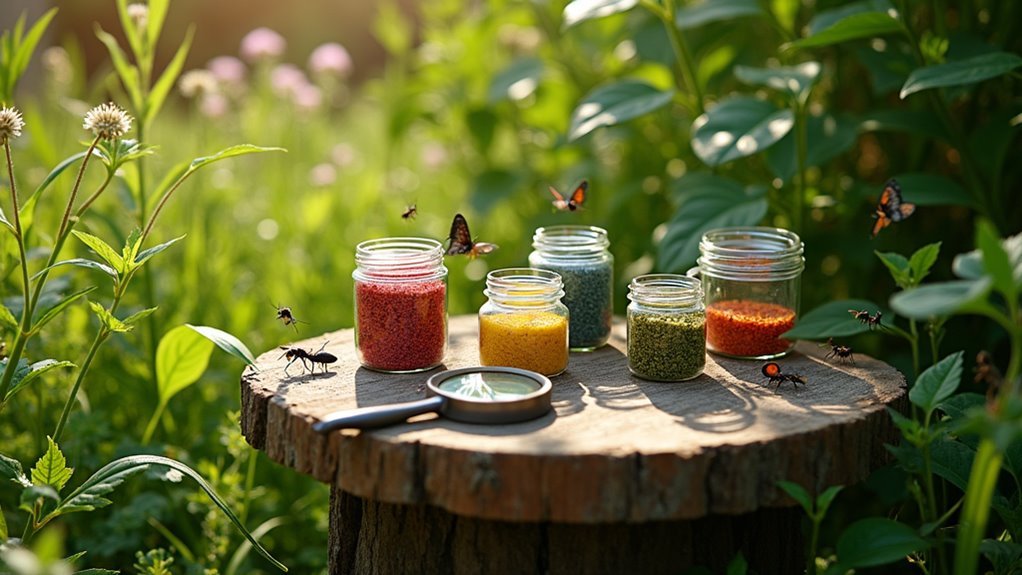Your landscaping naturally repels pests by creating biodiverse ecosystems that attract beneficial predators like ladybugs and birds who control harmful insects. When you plant native species and use companion planting with basil, marigolds, and lavender, you’ll confuse pests with natural scents while providing habitat for pest-eating insects. Strategic plant spacing improves air circulation, preventing disease-promoting humidity, while physical barriers like raised beds and gravel paths block crawling pests. Discover how these natural methods can reduce pest populations by 50%.
The Science Behind Natural Pest Deterrent Landscaping

When you design your landscape with pest deterrence in mind, you’re harnessing natural ecological principles that have evolved over millions of years.
Native plants create biodiversity hotspots that attract beneficial predators like ladybugs and dragonflies, establishing biological control systems that eliminate harmful insects without chemicals.
Aromatic plants such as basil, rosemary, and marigolds release volatile compounds that disrupt pest sensory systems, creating effective natural pest barriers through scent-based deterrence.
Companion planting disrupts pest reproductive cycles by creating environmental confusion and reducing host plant concentration.
When you enrich soil with organic matter, you’re strengthening plant immune systems, making them naturally resistant to infestations.
Physical barriers like mesh netting work alongside these biological methods, creating multi-layered defense systems that protect your landscape while maintaining ecological balance.
Strategic Plant Selection for Pest Prevention
Building on these natural defense mechanisms, your plant choices serve as the foundation for effective pest prevention. Smart selection creates layers of protection that work together seamlessly.
Strategic plant selection builds natural defense layers that work in harmony, creating effective pest prevention without chemical intervention.
Consider these strategic approaches for maximum pest control effectiveness:
- Choose native plants that support local beneficial insects and predators who’ll naturally manage harmful pest populations in your garden.
- Plant pest-repellent varieties like basil, marigolds, and chrysanthemums that emit natural scents to deter common garden invaders.
- Practice companion planting by pairing specific plants together to confuse pests with diverse appearances and conflicting scents.
- Select disease-resistant cultivars that maintain better health and reduce vulnerability to pest-related problems.
You’ll create a self-sustaining ecosystem where plants actively defend themselves and each other, eliminating your need for chemical interventions.
Creating Biodiversity to Support Beneficial Insects

Since diverse ecosystems naturally regulate themselves through predator-prey relationships, you’ll want to cultivate a rich variety of flowering plants that attract beneficial insects like ladybugs, lacewings, and parasitic wasps.
Focus on native species that enhance local biodiversity while providing essential habitat and food sources for these natural pest controllers.
You’ll maximize effectiveness by selecting plants that attract beneficial insects with different bloom times, ensuring continuous nectar and pollen availability throughout the growing season.
Consider companion planting strategies, such as pairing marigolds with vegetables, to simultaneously deter pests while supporting predatory insects.
Create additional habitats by establishing insect hotels or leaving undisturbed garden areas where beneficial insects can shelter and reproduce, strengthening your garden’s natural defense system.
Native Plants as Natural Pest Defense Systems
You’ll discover that native plants function as powerful pest defense systems by naturally attracting beneficial predators like ladybugs and predatory wasps to your landscape.
These indigenous species create an environment where helpful insects thrive and actively hunt down harmful pests, eliminating the need for chemical interventions.
Attracting Beneficial Predators
When you plant native species in your garden, you’re fundamentally recruiting a team of natural bodyguards that’ll work around the clock to protect your plants.
Attracting beneficial predators becomes effortless when you choose flora that’s perfectly suited to your local environment.
These natural allies create an impressive defense system:
- Ladybugs and lacewings actively hunt aphids, mites, and other destructive insects
- Native wildflowers provide essential nectar and pollen to sustain predators throughout their lifecycle
- Diverse plantings encourage balanced ecosystems that support both predators and pollinators
- Research-backed results show pest populations can decrease by up to 50% in biodiverse native gardens
You’ll find that native plants’ natural resilience reduces disease susceptibility while simultaneously creating habitat for beneficial insects that’ll handle your pest problems naturally.
Chemical-Free Pest Deterrence
While commercial pesticides flood gardens with harsh chemicals, native plants deploy their own sophisticated arsenal of natural compounds that send pests packing without poisoning your landscape. These plants have evolved defensive mechanisms over thousands of years, producing specific oils, alkaloids, and other compounds that naturally repel harmful insects while remaining safe for beneficial species.
| Plant Type | Natural Compound | Target Pests |
|---|---|---|
| Marigolds | Thiophenes | Aphids, whiteflies |
| Lavender | Linalool | Moths, fleas |
| Mint | Menthol | Ants, rodents |
| Chrysanthemums | Pyrethrin | Various insects |
You’ll find that native plants create a self-sustaining defense network, reducing your maintenance needs while protecting your garden through nature’s own proven methods.
Companion Planting Techniques That Repel Harmful Insects

Although chemical pesticides offer quick results, companion planting harnesses nature’s own defense mechanisms to create a pest-resistant garden environment.
Companion planting transforms your garden into a natural fortress, using plant partnerships to outsmart pests without chemical warfare.
You’ll discover that strategic plant partnerships naturally deter harmful insects while promoting healthier growth.
Effective companion planting techniques include:
- Marigolds with vegetables – Their distinctive scent repels nematodes and aphids from surrounding crops
- Basil alongside tomatoes – Enhances tomato flavor while deterring whiteflies, aphids, and spider mites
- Mint and rosemary interplanting – Strong aromas naturally repel mosquitoes and cabbage moths
- Garlic as pest masking – Powerful odor conceals attractive scents from neighboring plants
You’re also creating enhanced biodiversity that encourages beneficial insects to establish natural pest control.
This balanced ecosystem eliminates your need for chemical interventions while maintaining effective protection against destructive pests.
Soil Health and Its Role in Pest Resistance
Beneath your garden’s surface lies the foundation of natural pest resistance—healthy, nutrient-rich soil that strengthens plants from the ground up.
When you prioritize soil health, you’re creating an environment where plants develop robust root systems and enhanced resilience against pest pressures.
Start with a soil analysis to identify nutrient deficiencies and pH imbalances.
You’ll then know exactly what amendments your soil needs.
Regular additions of compost and organic fertilizers boost biological diversity, creating a balanced ecosystem that naturally suppresses pest populations.
Practice crop rotation and incorporate organic matter to reduce soil-borne diseases.
Well-aerated, nutrient-dense soil supports beneficial microbial communities that improve drainage and enhance your plants’ natural pest resistance, eliminating the need for chemical interventions.
Physical Barriers Through Landscape Design
You can create effective pest barriers by thoughtfully positioning plants and hardscape elements throughout your landscape.
Strategic placement of dense hedges or thorny shrubs around vulnerable areas confuses pests and blocks their access routes to your prized plants.
Hardscape features like gravel pathways, rock borders, and raised bed barriers physically deter crawling pests while adding functional beauty to your garden design.
Strategic Plant Placement Barriers
When you strategically position plants throughout your landscape, you’re creating natural fortifications that block pest access to your most vulnerable garden areas. This approach transforms your garden into a defensive network where each plant serves a protective purpose.
Strategic plant placement works through several effective methods:
- Tall barriers – Position hedges and larger plants as windbreaks to disrupt flying pests’ flight patterns.
- Dense ground coverage – Use thick plantings to suppress weeds that attract harmful insects.
- Native plant diversity – Mix indigenous species to attract beneficial predators that control pest populations.
- Layered protection – Create multiple plant heights to form thorough barriers.
You’ll find this technique particularly effective because it doesn’t rely on chemicals yet provides consistent protection while enhancing your landscape’s natural beauty.
Hardscape Pest Deterrents
Beyond living plant barriers, hardscape elements form permanent defensive structures that physically block pests from reaching your garden’s most valuable areas. Stone walls, patios, and walkways create physical barriers that deter unwanted intruders from entering your garden zones.
Raised beds made of wood or stone elevate your plants while preventing burrowing animals like rabbits and gophers from accessing root systems. You’ll enhance protection by installing mesh bottoms in these beds, which blocks underground pests while maintaining proper drainage.
Properly placed fencing buried 8-10 inches underground effectively blocks larger animals such as deer and dogs. These hardscape pest deterrents also include gravel or pebbles around plant bases, creating inhospitable surfaces that reduce crawling pests like slugs and snails.
Trap Crops and Decoy Plants for Pest Diversion
As gardeners seek sustainable alternatives to chemical pesticides, trap crops and decoy plants offer an ingenious solution that harnesses nature’s own mechanisms to protect valuable plants.
You’ll find that these strategic plantings work by attracting pests away from your main crops, concentrating them in designated areas where you can manage them more effectively.
Research shows trap crops can reduce pest populations by up to 80% in your primary garden areas.
Trap crops can dramatically reduce pest populations by up to 80% in your primary garden areas through strategic natural pest management.
Here’s how to implement this natural pest control strategy:
- Plant marigolds and nasturtiums as decoy plants around garden perimeters
- Select trap crops that appeal specifically to your local pest species
- Position these plants where they won’t compete with main crops for resources
- Monitor and manage concentrated pest populations in trap crop areas
This approach promotes biodiversity while reducing chemical dependency.
Natural Predator Habitats in Garden Design
You can transform your garden into a natural pest control system by creating habitats that attract beneficial insects and predators.
Focus on incorporating diverse plant species, native varieties, and flowers that bloom throughout the season to provide continuous food sources for ladybugs, lacewings, and parasitic wasps.
Design your landscape with varied heights, structures like hedgerows, and features such as insect hotels to offer shelter and nesting sites for the predatory organisms that’ll keep pest populations in check.
Creating Beneficial Insect Habitats
While chemical pesticides might offer quick results, transforming your landscape into a haven for beneficial insects provides a sustainable, long-term solution for pest control.
You’ll create an ecosystem where nature handles pest management automatically.
To establish thriving beneficial insect habitats, you should:
- Plant diverse flowering species like yarrow, daisies, and marigolds that attract ladybugs and lacewings
- Build shelter areas such as brush piles or insect hotels for predatory insects to establish residence
- Install water sources like small ponds or birdbaths to support beneficial insects and pest-eating birds
- Use companion planting techniques, growing pest-repellent plants alongside vulnerable crops
Incorporating native plants strengthens this approach by supporting local ecosystems and providing natural habitats that beneficial insects recognize and utilize effectively.
Attracting Natural Pest Predators
Beyond attracting beneficial insects, your garden design can create specialized habitats that draw larger natural predators like birds, bats, and spiders into your landscape. These predators form an essential component of attracting natural pest predators through thoughtful planning.
Native plants provide vital food sources and nesting materials for birds, while dense shrubs offer shelter. Installing bat boxes near water sources encourages these nocturnal hunters. Ground cover creates hunting grounds for spiders and other predatory arthropods.
| Predator Type | Habitat Feature | Target Pests | Garden Benefit |
|---|---|---|---|
| Birds | Native berry bushes | Caterpillars, aphids | Healthy plants, reduced damage |
| Bats | Water features, boxes | Flying insects | Night pest control |
| Spiders | Ground cover, mulch | Small insects | Continuous hunting |
| Beneficial beetles | Log piles, stones | Grubs, larvae | Soil pest management |
| Lizards | Rock gardens | Ants, small insects | Integrated Pest control |
This Integrated Pest approach creates sustainable, chemical-free protection.
Designing Wildlife-Friendly Garden Spaces
Creating strategic garden zones with varying heights, textures, and microclimates transforms your landscape into a thriving ecosystem that naturally controls pests.
You’ll establish wildlife-friendly garden spaces that support beneficial predators while deterring harmful insects.
Design your garden with these essential elements:
- Diverse plant structures – Layer tall trees, medium shrubs, and ground cover to accommodate different predator species.
- Water features – Install small ponds or birdbaths to provide drinking and breeding grounds for beneficial insects and amphibians.
- Natural shelter options – Add brush piles, rock gardens, and birdhouses for predator protection and nesting.
- Companion plant clusters – Group pest-repellent plants near vulnerable crops to create natural barriers.
This thoughtful approach creates sustainable habitats where ladybugs, bats, toads, and predatory birds thrive, maintaining your garden’s natural pest control system year-round.
Aromatic Plants That Naturally Repel Common Pests
Although chemical pesticides offer quick results, aromatic plants provide a natural and sustainable approach to pest control that’s both effective and environmentally friendly.
You’ll find that herbs like basil, rosemary, and mint emit powerful scents that mask nearby plants’ odors, confusing pests and preventing them from locating their preferred hosts.
Marigolds release natural insect repellents that effectively deter nematodes, aphids, and whiteflies from your crops.
You can plant chives to create protective barriers with their pungent aroma, which repels aphids and other common garden pests.
Lavender offers dual benefits—its pleasant fragrance repels mosquitoes and moths while enhancing your garden’s appeal.
Additionally, you’ll want to contemplate nasturtiums as trap crops that draw pests away from your valuable plants.
Proper Plant Spacing for Disease and Pest Prevention
You’ll dramatically reduce pest problems by giving your plants adequate breathing room between each other.
Proper spacing creates airflow that prevents the humid, stagnant conditions where diseases thrive and pests multiply.
When plants aren’t competing for space, they’re stronger and less vulnerable to infestations that target weakened vegetation.
Air Circulation Benefits
When you space plants properly, you create natural air highways that dramatically reduce pest and disease problems in your landscape. Enhanced air circulation keeps plants healthy by lowering humidity levels around foliage, making conditions less favorable for fungal diseases that thrive in damp environments.
These air highways deliver multiple protective benefits:
- Faster drying – Your plants’ leaves dry quickly after rain or watering, preventing disease establishment.
- Better light penetration – Adequate spacing reduces plant stress and disease susceptibility.
- Pest disruption – Proper distance makes it harder for pests to move between neighboring plants.
- Optimal growth conditions – Following spacing guidelines (12-18 inches for leafy crops) maximizes air flow.
You’ll notice fewer pest infestations and healthier plants when you prioritize proper spacing in your landscape design.
Disease Prevention Through Spacing
Beyond simply improving air flow, strategic plant spacing serves as your first line of defense against disease outbreaks in your garden.
When you overcrowd plants, you’re creating perfect conditions for pathogens to spread through direct contact between infected and healthy foliage. Proper spacing breaks this transmission chain while reducing competition for nutrients that weakens plant immunity.
You’ll also limit pest infestations by eliminating the cramped conditions insects love. Well-spaced plants receive adequate sunlight, reducing stress that makes them vulnerable to both diseases and pests.
Following recommended spacing guidelines for your specific crops dramatically decreases disease incidence. Additionally, proper layouts give you easier access for monitoring and maintenance, enabling early detection of problems.
Disease prevention through spacing isn’t just practical—it’s essential for chemical-free garden management.
Pest Access Reduction
Strategic spacing creates physical barriers that make it considerably harder for pests to move between your plants and establish widespread infestations.
When you implement pest access reduction through proper spacing, you’re fundamentally creating natural moats that interrupt pest migration patterns.
Well-spaced plants offer multiple benefits for natural pest management:
- Enhanced monitoring capabilities – You’ll spot pest activity earlier when plants aren’t crowded together
- Reduced pathogen transmission – Leaves can’t touch and spread diseases between plants
- Improved air circulation – Better airflow keeps humidity low and creates unfavorable pest conditions
- Stronger plant immunity – Less competition for resources means healthy plants that naturally resist infestations
This strategic approach helps you Control Pests Without relying on chemical treatments, creating a thriving garden ecosystem.
Seasonal Landscaping Strategies for Year-Round Protection
Although many homeowners focus on reactive pest control during active growing seasons, you’ll achieve far better results by implementing year-round landscaping strategies that work with nature’s cycles. Each season offers unique opportunities to disrupt pest populations while strengthening your landscape’s natural defenses.
| Season | Strategy | Pest Control Benefit |
|---|---|---|
| Spring | Plant native species | Attracts beneficial insects |
| Summer | Apply mulch layers | Creates pest barriers |
| Fall | Install diverse plantings | Establishes predator habitats |
| Winter | Grow cover crops | Disrupts pest life cycles |
| Year-round | Rotate crop locations | Prevents pest buildup |
These seasonal landscaping strategies create multiple defense layers that work together. You’ll find that rotating crops prevents specific pests from establishing permanent populations, while maintaining plant diversity guarantees natural predators have year-round habitat support.
Water Management and Drainage for Pest Control
When water collects in unwanted areas of your landscape, you’re fundamentally rolling out the red carpet for mosquitoes, fungus gnats, and countless other pests that thrive in moist conditions.
Effective water management eliminates these breeding grounds while creating an inhospitable environment for pest infestations.
Proper drainage transforms your landscape from a pest paradise into a fortress that naturally repels unwanted invaders.
Smart drainage solutions protect your plants from root rot and fungal diseases that weaken their natural defenses against insects:
- Install and maintain gutters and downspouts to direct water away from planting areas
- Create contours and swales in your landscape to guide water flow naturally
- Incorporate organic matter into soil to improve drainage and structure
- Regular inspection of drainage systems prevents water accumulation
Maintaining Healthy Ecosystems Through Organic Landscaping
Beyond addressing drainage issues, you’ll find that organic landscaping practices create the foundation for a thriving ecosystem that naturally keeps pests in check. By incorporating native plants and maintaining soil health through composting and mulching, you’re building natural defenses against garden pests. Companion planting creates barriers where beneficial plants repel harmful insects while attracting pollinators and predators.
| Organic Practice | Natural Benefit | Pest Control Result |
|---|---|---|
| Native plantings | Attract beneficial insects | Natural predator populations |
| Companion planting | Plant-based pest deterrence | Chemical-free protection |
| Soil composting | Enhanced plant immunity | Disease-resistant gardens |
| Habitat creation | Bird and predator shelter | Self-regulating ecosystem |
This approach eliminates chemical runoff, protecting waterways while encouraging natural pest predators that maintain ecosystem balance without intervention.
Frequently Asked Questions
Can Insect Pests Be Controlled Without Using Chemical Insecticides?
You can control insect pests without chemical insecticides by planting pest-repellent varieties, creating beneficial insect habitats, using physical barriers, rotating crops, and manually removing pests during regular garden inspections.
How Do Organic Farmers Control Pests Without Pesticides?
You’ll rotate crops to disrupt pest cycles, introduce beneficial insects like ladybugs, practice companion planting with pest-repelling plants, monitor regularly for manual removal, and apply natural substances like neem oil.
Why Should Gardeners Never Use Pesticides?
You shouldn’t use pesticides because they’ll harm beneficial insects, contaminate water sources, and create resistant pest populations. Instead, you can achieve better long-term results using natural methods that protect biodiversity.
What Landscaping Keeps Bugs Away?
You’ll repel bugs by planting basil, marigolds, and chrysanthemums around your property. Install mesh barriers, use companion planting like carrots with onions, and create diverse plant heights to attract beneficial insects that naturally control pests.
In Summary
You’ll discover that strategic landscaping creates a powerful, chemical-free defense against pests. By selecting the right plants, maintaining proper spacing, and fostering biodiversity, you’re building a natural ecosystem that works for you around the clock. Your thoughtful plant choices and water management won’t just repel harmful insects—they’ll attract beneficial ones too. You’re creating a sustainable, healthy environment that protects itself while enhancing your property’s beauty and value.





Leave a Reply